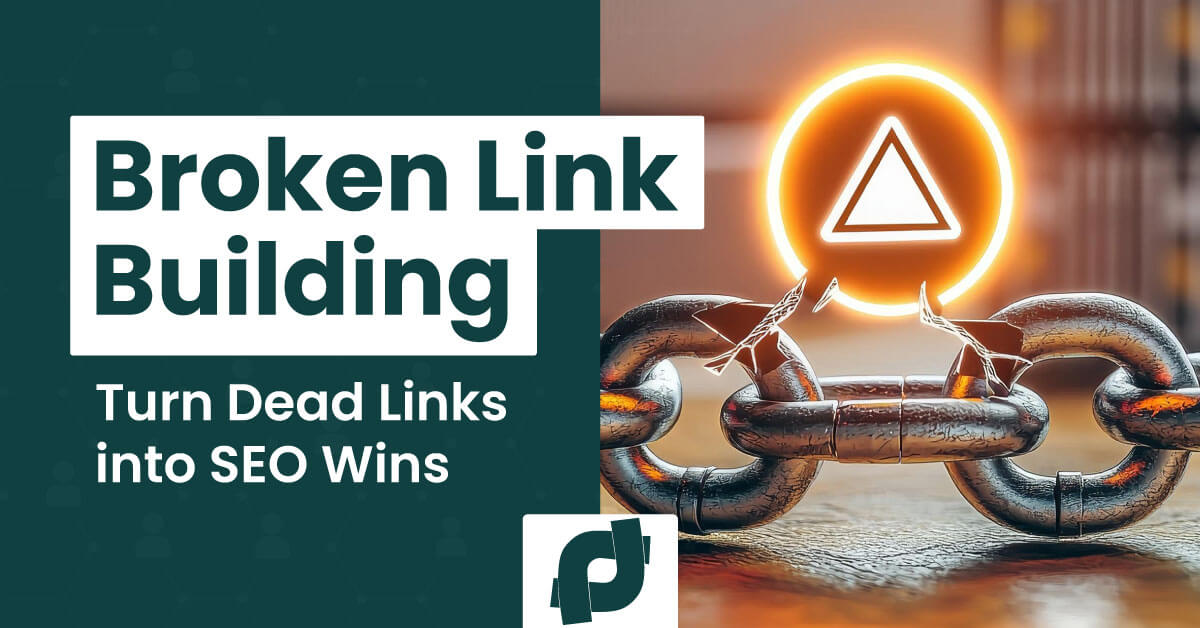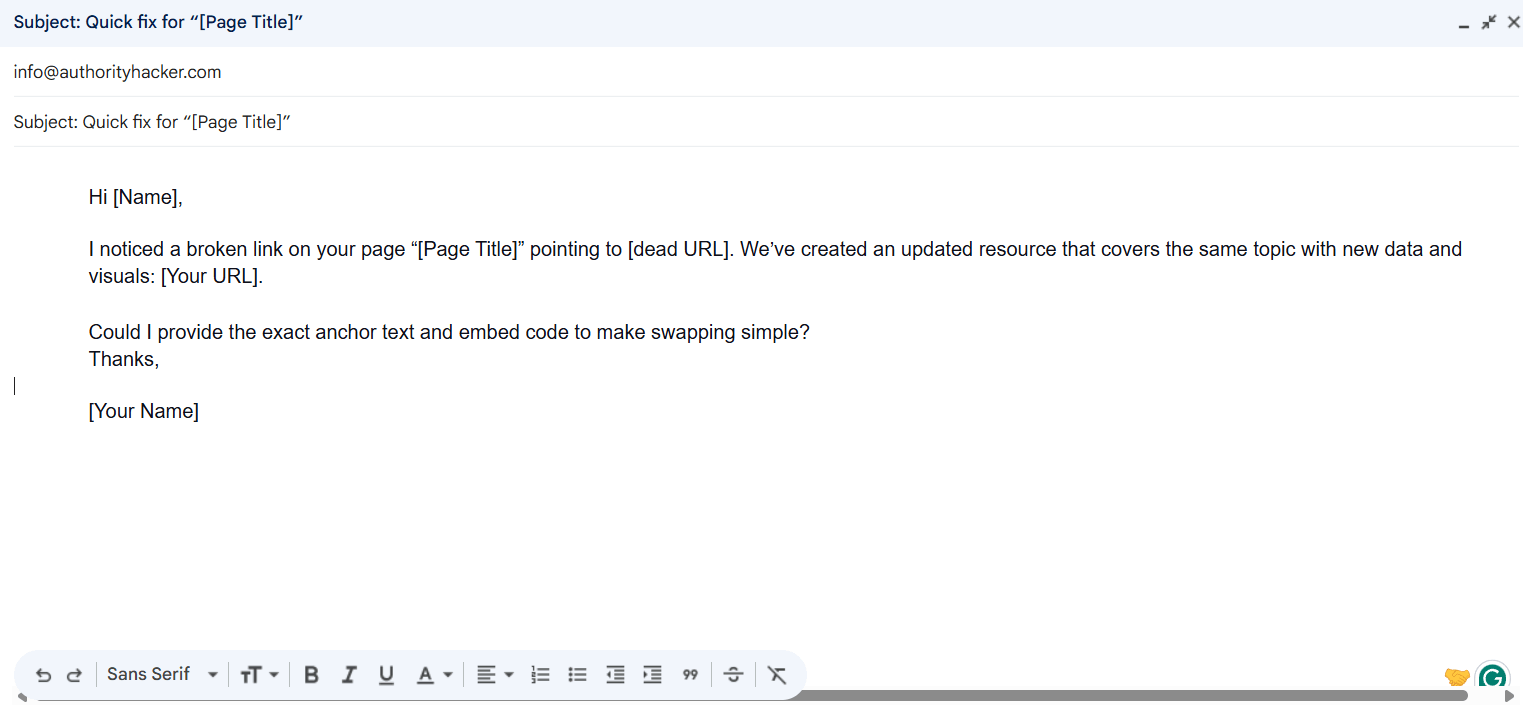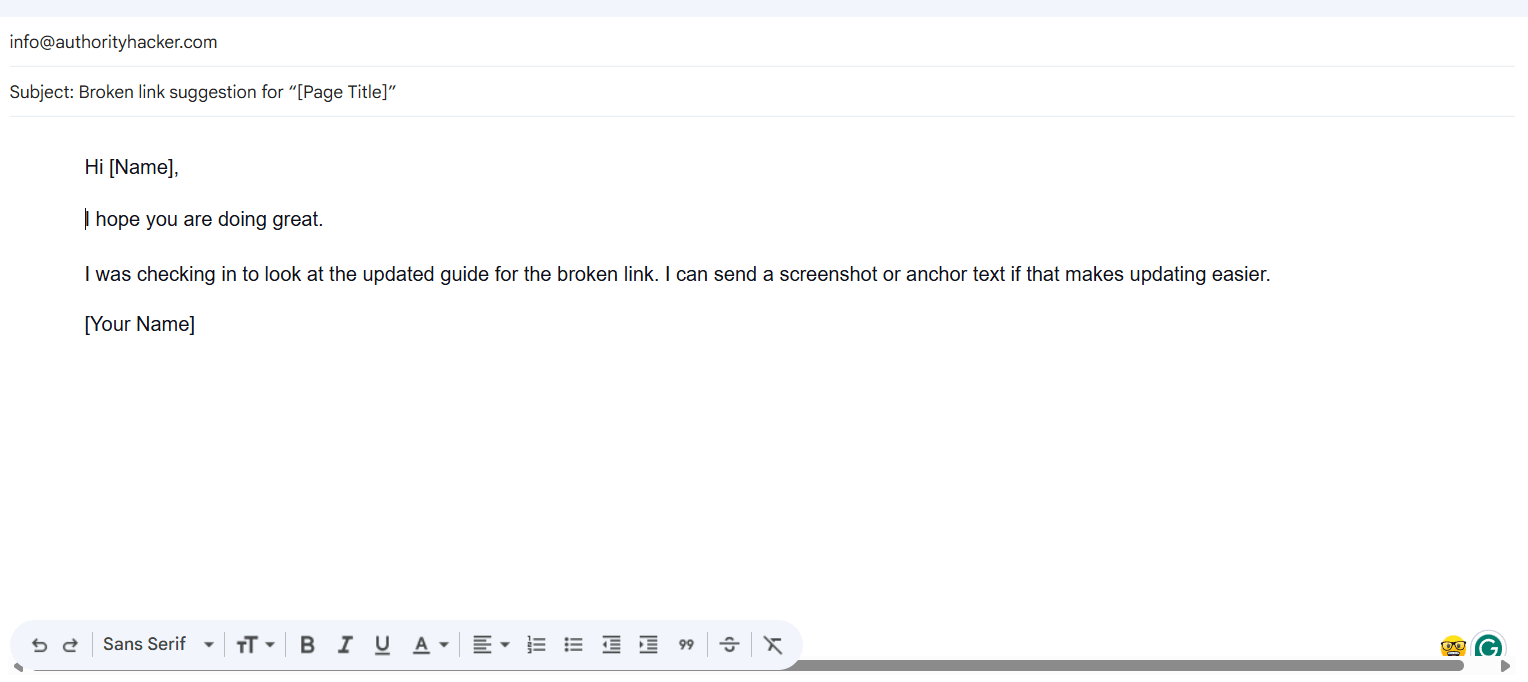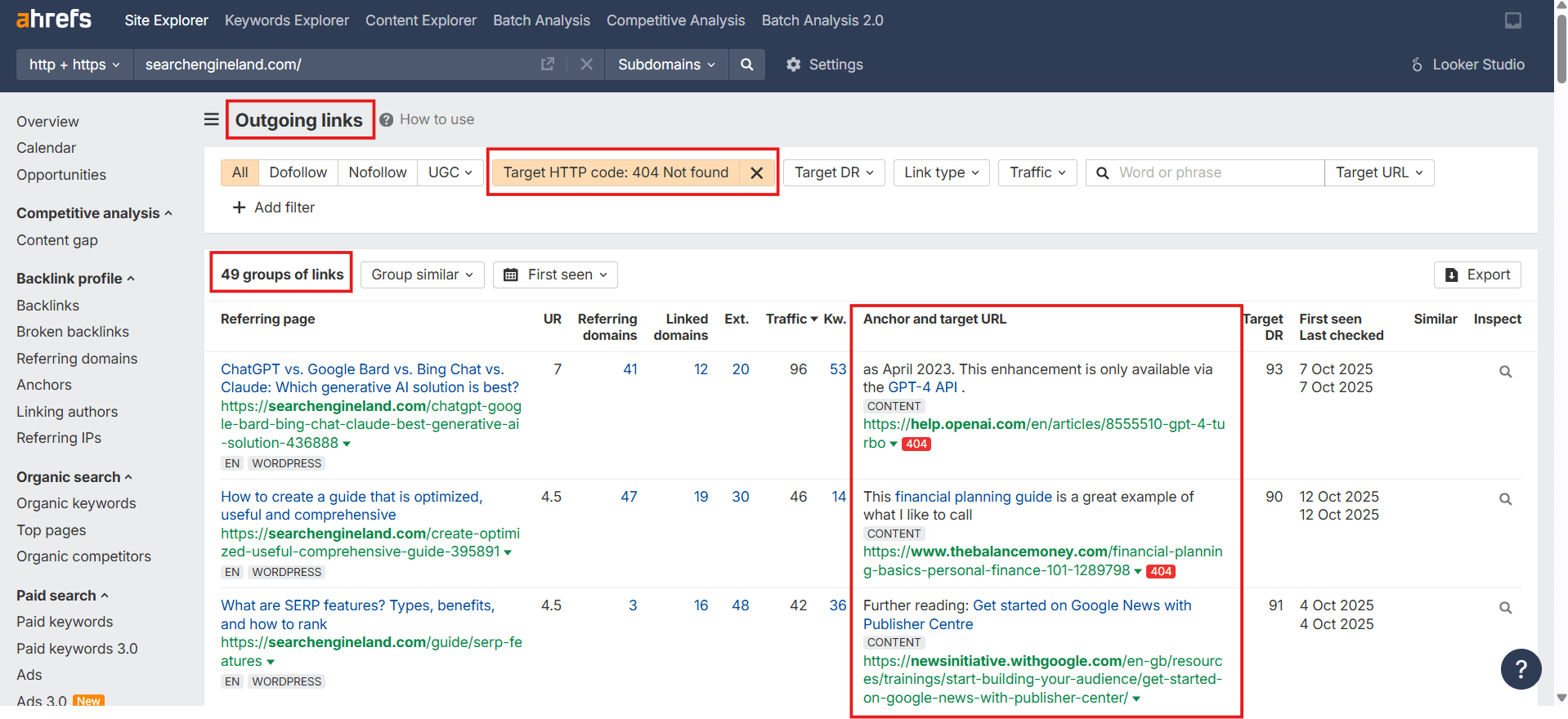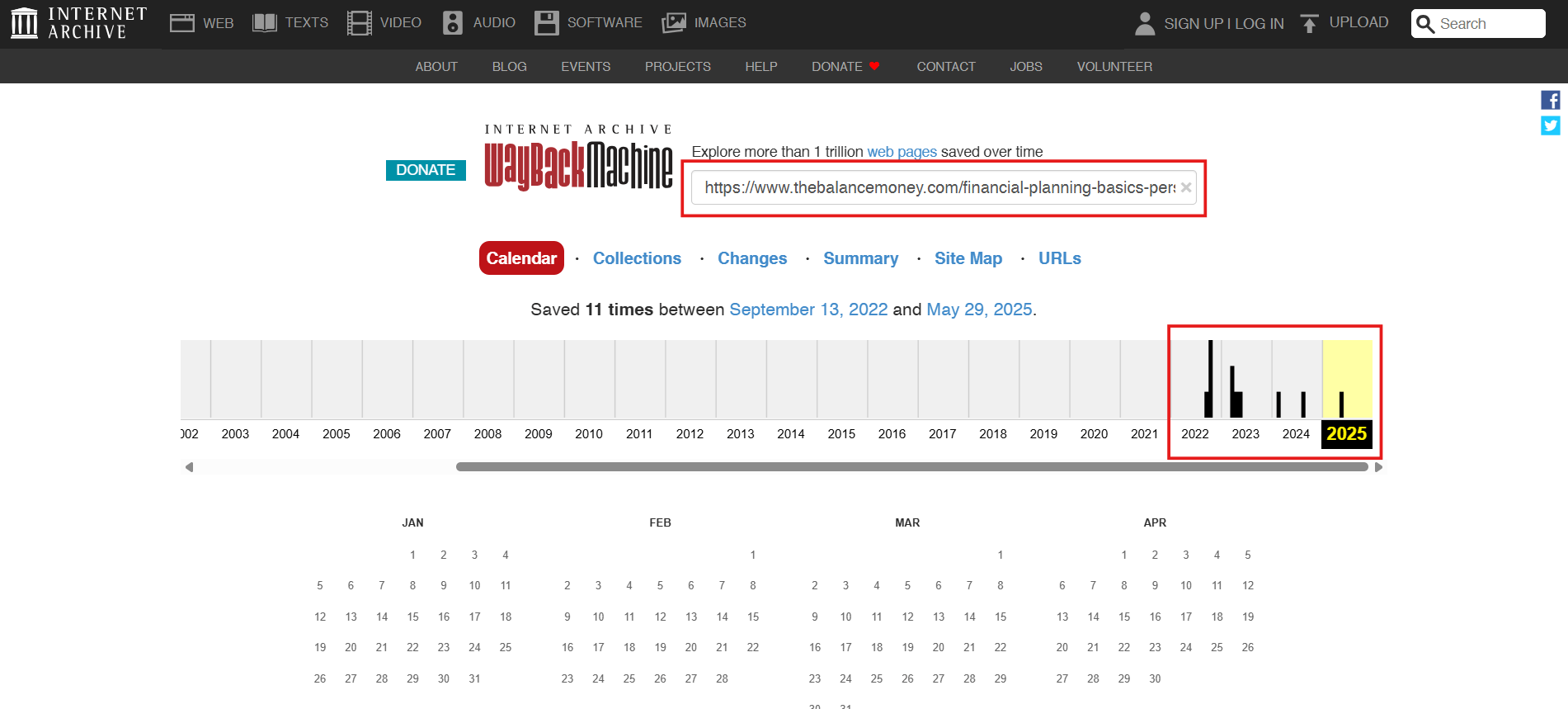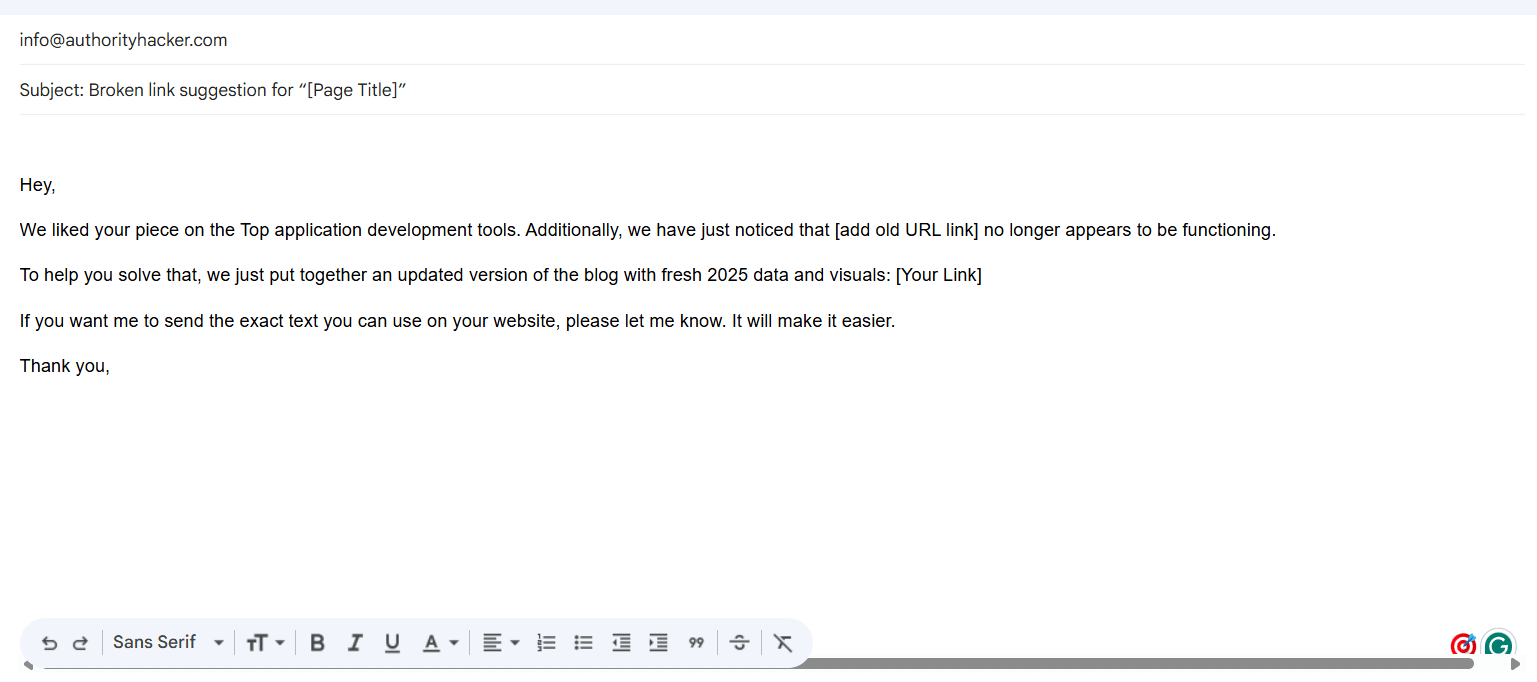Broken link building is an effective way to earn high-quality backlinks by providing valuable information. This strategy hits two targets with one stone: it offers value and enhances user experience simultaneously.
At the Outreach Desk, we understand the importance of backlinks and actively apply link reclamation strategies. But there is a catch: what if the best opportunities are hidden behind 404 pages? That’s why we follow a high-conviction approach. We identify broken references on relevant pages, create replacement content that outperforms the competitor, and pitch it with thoughtful, publisher-first outreach.
The result? We secure editorial backlinks that stick and build relationships that last.
With that said, let’s dive into broken link building and why it remains a powerful SEO strategy.
What Is Broken Link Building (and Why It Still Works)?
Broken link building is an SEO strategy that involves identifying broken or dead links (404 errors) on other websites and suggesting your own content as a replacement. This helps site owners fix the dead links while earning you a valuable backlink.
This way, the broken link building method is highly beneficial to web admins and SEOs. Since web admins will get the replacement of their broken link by getting high-quality content, and SEOs will earn a link to boost their website traffic.
The real reason behind the working of broken link building is not about gaming the algorithm. Instead, it is about providing value by helping editors fix the real profile.
Benefits of Broken Link Building
Building broken links is not just a white-hat link-building tactic; it’s a solid way to build credibility, drive traffic, and foster long-term relationships. Let’s explore some of the key benefits of building broken links.
Earn High-Authority, Contextual Backlinks
The key to building broken links is to get backlinks from strong and authoritative websites, usually with a domain rating of 70 or above. Unlike generic link placement, where you might be shooting in the dark, broken link placements are a sure-shot way to build link-building opportunities that Google trusts.
This practice is not random; broken link-building opportunities are often found in articles, guides, and resources your readers go through every day.
The reason why this matters is that search engines value context; therefore, a link embedded into your topic signals authority and relevance compared to a sidebar or footer link.
Strengthen your site’s E-E-A-T
Google prioritizes information that is reliable, helpful, and provides real benefits to people. Therefore, practising broken link building directly signals to Google that you are building trust and authority at the same time.
The critical thing to note is to avoid replacing the content only for the sake of it. But the goal should be to outperform the content by providing value.
By adding updated data, clear examples, and improving readability (for instance, by using tables), you enhance the quality of your content. These improvements help strengthen your site’s E-E-A-T – Expertise, Experience, Authority, and Trust.
Build genuine relationships with site owners
The practice of link building is relationship-driven. Building strong relationships with site owners ultimately helps you strengthen your backlink exchange. That’s where the role of the Outreach Desk comes in, where our focus is on value-driven communication and building long-term relationships.
Most publishers are busy. By doing the legwork, identifying dead links, creating ready-to-use replacements, and suggesting relevant anchor text, you can significantly increase your response rate.
Recover lost link equity
Recovering the lost link equity allows you to help the blog rise from the dead.
In short, you can regain referral traffic and link equity by creating a new, value-driven blog with relevant assets. Then, redirect or replace the broken link to restore its SEO value.
In short, this practice offers an opportunity to replace a 404 page receiving thousands of visitors with relevant and trustworthy content. By this, you are not only recovering your lost traffic but also seeing a significant boost in ranking as well.
Improve organic rankings and referral traffic
The most underrated and still the most useful thing is your website. It will improve organic ranking and referral traffic. If you build a high-quality contextual replacement, it will do more than earn a backlink. It also drives engagement and improves search performance.
Compared to generic link building, these links live in your content. Your audience is already consuming it, which increases the likelihood of referrals and clicks.
The most underrated thing and still the most useful is your website. It helps improve organic ranking and referral traffic. If you build a high-quality, contextual replacement, it will do more than earn a backlink. It also drives engagement and boosts search performance.
How Broken Link Building Works (Step-by-Step)
Broken link building sounds simple: find a 404 link, pitch a replacement, and get a backlink. Not so easy. The reality is this is a mix of research, relevance, and most importantly, relationship building. The following is a step-by-step guide to building broken links that actually work.
Step 1 – Find broken links
The initial step is to discover where links have died.
Don’t waste time and effort skimming low-value pages. Follow this method instead.
Go to Ahrefs > use the site explorer > backlinks > broken backlinks filter to find 404s pointing to relevant topics.
Another Chrome extension is Check My Links, which quickly scans individual pages for broken outbound links.
To practice SEO link building, In SEMrush, you can use the Backlink Audit or Backlink Gap tool to uncover competitor backlinks that don’t work anymore.
Let’s discuss high-value examples:
Resource pages: “Best websites to find a job” or “Top guides on how to cook” often link to multiple external sources.
Competitor backlink profiles: Find the link competitors earned that now lead to missing pages.
Wikipedia dead links: Often, Wikipedia editors remove outdated references; replacing these with high-quality resources can be extremely authoritative.
Step 2 – Vet link prospects
Every 404 is not worth chasing. The vetting part is crucial and ensures you focus on pages that will drive real SEO value. Here is the vetting checklist to follow.
- Check topic relevance: If the dead page doesn’t align with your content, skip it.
- Prioritize domain authority: Focus on domains with a DA/DR above 50 to gain stronger link equity.
- Page-level metrics: Check traffic, referring domain, and social shares, since a page with no visibility may not be worth the effort.
- Link placement: Links within the main content hold more value than sidebar or footer links.
Pro tip: Always think like an editor, and ask yourself, “Would I replace this broken link if I were managing this page?” If yes, you are on the right track.
Step 3 – Create a replacement page
Always remember, your replacement page must outperform the original. Editors won’t swap a dead link for generic or mediocre content. They expect a superior level of content delivered to their readers that has not been published before.
Here are some tips for building a superior replacement:
If you are managing, let’s say, a top 10 tools list, it is essential to use a list update format for 2026. People link to a list; therefore, it is essential to give them an updated one.
But it’s not as easy as it sounds; people still use generic descriptions instead of updating them as per last year.
Along with information, keep the visuals in check. Add a few screenshots of the tool, create a comparison table, and your honest review of the tool.
Like, we tried this tool for 2 weeks straight, and here is what changed.
Instead of gaming the algorithm, share your genuine review and drop in a short author bio at the top. Also, add resource links to all the bios, and if you ran your own test, explain how.
The last thing is to make it easy to scan, meaning use real headings and break up those paragraphs. If you want people to link to your page, make it easier for them to scan. Also, tell them what to do next, sign up, download something, and whatever makes sense.
For example, a dead link on a SaaS marketing guide can be easily replaced with a “Top Marketing Automation Tools 2026” page, with complete research, screenshots, and expert commentary-something better than the original page.
Step 4 – Do outreach
We have finally reached the stage where your replacement page exists, and it is time to reach out with value. Since outreach is not spam but a service, you are helping fix a real problem on the editor’s site.
3 principles to focus on
- Personalise-Reference the broken link specifically
- Be concise-Show the dead URL, your replacement, and optional anchor text.
- Make it easy-Try to provide embed code or suggested text so the editor doesn’t need to rewrite.
The following broken link email template will save you time.
You would also require a follow-up template (after 4 to 6 days).
Bad vs. Good Outreach –
Always write detailed outreach messages instead of just saying “Hi, can you link to my site?” – you will be ignored.
Instead, write, “Hi [Name], I noticed a dead link on your page, and here’s a ready-to-use replacement with screenshots. Please let me know if this works for you.”
Why Broken Link Building Works So Well in 2026
Despite the constant shift in the Google algorithm, the popularity of broken link building never fades out. Even in 2026, it provides win-win scenarios to web admins and SEOs. Webmasters get to improve their user experience by fixing a broken link, whereas SEOs gain a high-quality natural backlink.
Editorial & contextual link power
Outreach Desk’s hyperfocus is on DR 70+ sites, securing links that naturally integrate into your content instead of footers or sidebars. Google trusts these links for their topical authority. It means the link drives organic traffic from audiences as well as passes relevant link equity from audiences engaged with your content.
Strengthens E-E-A-T and brand trust
Strengthen your brand’s EEAT (Expertise, Experience, Authority, and Trust) by infusing research and high value into your content.
Since editors appreciate the upgrade, readers get accurate, helpful information, and Google recognises your site as a credible, authoritative source, helping rankings and reputation at the same time.
Outreach Desk’s Proven Broken Link Building Process
At the Outreach Desk, we follow a step-by-step process that offers you guaranteed results. Let us understand the process in detail for easy understanding.
Step 1: Website audit & niche mapping
A website audit is crucial at the beginning of every campaign. Outreach Desk’s specialists evaluate your backlink profile, topical clusters, and anchor text distribution to identify where new links will have the most impact.
The next step will be to conduct nice mapping, understanding the ecosystem your brand competes in. This involves
Pinpointing relevant content categories (e.g., SaaS, healthtech, fintech)
Finding the top-ranking competitors and the publishers linking to them
We did this for a cybersecurity client. Invested 2 weeks searching through 250+ industry blogs and forums talking about API security and pen testing. Found 43 broken links on decent sites, TechRadar Pro, SecurityWeek, and places like that.
But, the question comes to why even bother mapping all this out? Because when you reach out, you are not just asking for a link.
You’re saying, “Hey, the link on your site is broken, and I’ve got one that actually fits.” This is way better than cold-pitching random sites.
Step 2: Find out links through tools
Once the niche is clear, the next Outreach Desk’s research team initiate a massive scan using a combination of proprietary tools.
The following are used:
Use Ahrefs to identify broken outbound links on niche-relevant websites and competitor 404 pages
Leverage Google search operators to manually find link opportunities. Try using queries like: intitle:”resources” + “Industry”
Here is an example:
The outreach desk’s internal systems add data from these sources, ensuring the elimination of duplicates and sorting opportunities by domain authority, traffic volume, and topical relevance.
Step 3: Qualify & prioritize targets (link quality)
After collecting all the links, the next step is qualification, where the team separates gold from gravel. Outreach Desk’s link analysts use a multi-layered vetting matrix to ensure every target meets structural quality thresholds.
The following is the qualification checklist.
Domain Rating (DR):
Only sites with DR 50+ are considered; DR 70+ is preferred.
Research from Ahrefs shows that high-DR sites pass exponentially more link equity, improving ranking potential and crawl frequency.
Traffic:
Minimum of 1000 monthly organic visits (via Ahrefs or Semrush)
Traffic is a great benchmark to showcase the trust of the audience. Low-traffic, high-DR websites often belong to repurposed or expired domains, which can harm credibility.
Relevance:
The content should be relevant and closely align with the client’s keyword themes. Moz’s ranking factors study confirms that topical relevance between linked pages and linking is the strongest signal of link value in Google’s algorithm.
Step 4: Content recreation & optimization
Now, it is time to build the value of the dead page. The goal is to write a value-driven and research-backed blog that stands out from the competitors.
The Outreach Desk’s content team follows the workflow below.
1. Analyse the original page: always study what made the resource valuable: structure, keyword targeting, and the reasons websites are linked to it.
Use Wayback Machine to compare the older content from the original
2. Improve and rebuild:
It is crucial to improve and rebuild the blog by adding fresh data, visuals, tables, and case studies. Even Backlinko’s content study found that posts including the latest statistics and original visuals earn 94% more backlinks than just plain static content.
3. EEAT alignment with visual optimisation
Google’s Quality Rater Guidelines underscore how showing expertise, experience, authority, and trust improves ranking stability and trust. Along with that, ensure to integrate citations, expert quotes, and author bios and optimise the page for mobile and Core Web Vitals, as faster-loading pages reduce bounce rates and indirectly influence ranking.
Create replacement assets that deliver higher value than the broken page.
Step 5: Personalized outreach campaign
Outreach Desk believes in human-first backlink outreach, infusing real, human touch in every outreach campaign we do.
Our secret? It’s simple.
- Reference the exact broken URL in your message.
- Tone should be conversational instead of transactional.
- Offer value by providing a working replacement instead of a cold pitch.
Here is the sample for your better understanding
This custom and personalised outreach really gets better responses than generic and out-of-context outreach.
Step 6: Reporting & verification
We will show you the process we follow.
After every campaign, we will ensure to deliver the following
Clear proof that the link is real: live URLs, whether Google has indexed them, domain rating, and anchor text that actually works.
Number of traffic: Instead of randomly throwing numbers, we will systematically observe traffic changes after 30, 60, and 90 days using Search Console and Ahrefs.
Authentic screenshots – of every backlink we got for you.
Real outreach stats – the number of emails we send, response rates, and how many of them turned into links.
Drive AI Search Visibility with High-Authority Backlinks
We combine relevance, authority, and authenticity to secure links that strengthen your SEO footprint and maximize brand visibility across search and AI platforms.
Common Broken Link Building Mistakes (and How to Avoid Them)
Broken Link Building is not everyone’s cup of tea. There are some mistakes that you need to avoid to ensure a smooth process with fast results. We have made it easy for you by listing the common mistakes that prevail and ways to avoid them.
Not checking link relevancy
Relevant links are crucial to move the needle. The recent Google API leak confirmed what many SEOs had known for a long time: your links need to be relevant to move the needle.
Just to clarify, a relevant backlink doesn’t always mean it should be from the same niche, as long as your audiences overlap. For example, if a content marketer and website developer share the same target audience, a link exchange won’t hurt.
But a local business or a shop they helped advertise might not be that effective.
Weak replacement content
The biggest mistake is not being able to create content that’s ready to link to. That’s the key problem of many website owners. But the question comes to, what are the most linkable assets out there?
The most linkable assets out there are
- Statistics compilation
- Original research
- Infographics
- In-depth guides
- Interactive resources
- Free tools and calculators
Creating original and value-driven content takes time and is not cheap, but the investment is 100% worth it. Since that turns your generic blog post into a link-generating asset.
Spammy or generic outreach.
Most of the generic outreach emails end up in the spam folder, as email providers’ algorithms are merciless to them.
This happens especially when you rely too much on outreach tools. This practice isn’t only a waste of time, but it also harms your domains.
Avoid this by following the
- Know the receipt and their work
- Always include their name in the subject line and the email body.
- Make relevant references to their content
Targeting irrelevant or low-quality pages
The most common mistake is to chase any link that comes across. That’s the biggest mistake in broken link building. If the page isn’t topically relevant or lives on a low-quality site, that backlink certainly is not going to do any good.
For example, a health supplement brand earning a link from a tech gadget website is not going to do any good. The Google algorithm, after the March 2024 Spam Update, prioritises topical relevance and content quality when evaluating backlinks.
Quick tip: One relevant backlink from a respected industry blog is worth more than 30 links from unrelated or low-traffic websites.
No follow-up or tracking
66.5% of links have been lost in the last 9 years, and that’s a whopping 7% a year. This data from Ahrefs shouldn’t surprise you. Imagine working with an agency acquiring 100 links for $300-1000, and if 7 links disappear, then you could be losing $2100-7000 in link value.
Since links get removed internally or disappear as
Not tracking your backlinks is a serious and costly mistake.
The easiest way to prevent this is by using link-monitoring tools like All in One SEO or Broken Link Checker.
FAQs About Broken Link Building
Is broken link building still effective in 2026?
Indeed, when you priorities quality and publisher-first outreach, it is an effective strategy. The web has lots of link rot (when hyperlinks become non-functional or broken). The winners are those offering easy and better replacements.
How do I find broken links without paid tools?
You can start by scanning resource pages manually, using the Check My Links Chrome extension, and using site: searches paired with “resources” or “tools” to find pages to review. To find the links on scale, you can avail paid tools as well.
What is broken link building?
Broken link building is a way to identify 404 links on different websites and create a content piece on your website to replace inactive/dead links. Next, you can contact the webmaster to suggest that they use your content.
What are the benefits of broken link building?
Broken link building is a win-win situation for both the website owner, as they will be able to improve website experience by fixing a dead link, and you, the website user. On the other hand, you will be able to earn a valuable backlink, helping you boost your website ranking.
How do I check for broken backlinks in ahrefs?
You can easily check broken backlinks in Ahrefs: you can go to Site Explorer, enter the domain of your website, and navigate to “Broken Link” under the “Outgoing Links” section. Another method is you use the Best by Links report from “Pages” and filter the results by “HTTP code: 404 not found” and check the pages that are broken.
Is broken link building worth it in 2026?
We have discussed ways to build broken link building in innovative and sustainable ways to grow your website’s authority and traffic. By reclaiming lost links, earning contextual backlinks from trusted websites, and building your brand’s EEAT, you get results.
That’s where Outreach Desk comes into the picture; we handle everything from spotting the right opportunities to creating valuable and research-driven content. Also, our team reaches out personally to help you not just earn links but also build relationships and recover real value.
Drive AI Search Visibility with High-Authority Backlinks
We combine relevance, authority, and authenticity to secure links that strengthen your SEO footprint and maximize brand visibility across search and AI platforms.

